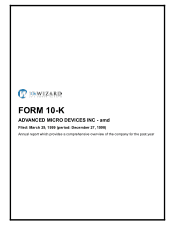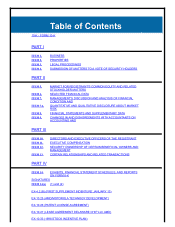AMD 1998 Annual Report Download - page 8
Download and view the complete annual report
Please find page 8 of the 1998 AMD annual report below. You can navigate through the pages in the report by either clicking on the pages listed below, or by using the keyword search tool below to find specific information within the annual report. . the volume of memory required to support faster microprocessors;
. the proliferation of increasingly complex PC software;
. the increasing use of cellular phones; and
. the increasing performance requirements of workstations, servers and
networking and telecommunications equipment.
We believe that Flash memory devices are being utilized for an expanding
range of uses. The ability of Flash memory devices to be electrically
rewritten to update parameters or system software provides greater flexibility
and ease of use than other non-volatile memory devices, such as ROM or EPROM
devices. Flash memory can be used to provide storage of control programs and
system-critical data in communication devices such as cellular telephones and
routers (devices used to transfer data between local area networks). Another
common application for Flash memory is in PC cards, which are inserted into
notebook and subnotebook computers or personal digital assistants to provide
added data storage.
The Logic Market
Logic devices consist of structurally interconnected groupings of simple
logical "AND" and logical "OR" functions, commonly described as "gates."
Typically, complex combinations of individual gates are required to implement
the specialized logic functions required for system applications. The greater
the number of gates on a logic device, the higher that logic device's density
and, in general, device cost (for a particular process and architecture).
Logic devices are generally grouped into five families of products (from
lowest density to highest density):
. standard logic devices;
. programmable logic devices (PLDs);
. conventional gate-arrays;
. standard cells; and
. full custom ICs.
Conventional gate-arrays, standard cells and full-custom ICs are often
referred to as application-specific ICs (ASICs).
Many manufacturers of electronic systems are striving to develop new and
increasingly complex products to rapidly address evolving market
opportunities. Achievement of this goal often precludes the use of standard
logic ICs and ASICs. Standard logic ICs generally perform simple functions and
are not customizable, limiting a manufacturer's ability to adequately
customize an end-product system. Although ASICs can be manufactured to perform
customized functions, they generally involve relatively high initial design,
engineering and manufacturing costs and significant design risks, and may
increase an end-product's time to market. As a result, ASICs are generally
limited to high-volume products, and products for which time to market may be
less critical.
Unlike ASICs and standard logic ICs, PLDs are standard products, purchased
by system manufacturers in an unprogrammed or blank state. Each system
manufacturer may then program the PLDs to perform a variety of specific logic
functions. Certain PLDs, including ours, are reprogrammable. This means that
the logic configuration can be modified after the device is initially
programmed, and, sometimes, while the PLD remains in the end-product system.
The programmable and reprogrammable characteristics of PLDs reduce the risk of
inventory obsolescence for system designers and distributors. The risk is
reduced because systems designers and distributors can stock a large number of
standard PLDs that may be programmed for a variety of applications. In
addition, system designers may make last minute design changes, reduce time to
market and accelerate design cycle time. Compared to standard logic ICs and
ASICs, PLDs allow system designers to more quickly design and implement custom
logic.
5
Source: ADVANCED MICRO DEVIC, 10-K, March 29, 1999





















